A travelogue with some new poetry by Jeffrey Stewart in it.
By Mark Fenton
Published June 27, 2007
Like Belacqua in Dante's Purgatory, I am a slacker by nature. When I go out to take pictures I like it when someone else can come with me. That way I might actually work at finding a story, not just lie down and go to sleep for a few hours, the same way you force yourself into the office some days rather than work from home because without other people "there" you'd just watch music videos on YouTube or buy stuff on eBay, or whatever it is you people do on line.
But it's hard to tear friends away from LimeWire to, say, join me for a tour of Meadowlands Power Centre. Even after I've assured them that they can bring their iPod and listen to their latest semi-legal Acid Mothers Temple acquisition; or that I won't feel insulted if they just nod politely while lost in a mind-melting Japanese psychedelic jam from The Penultimate Galactic Bordello Also The World You Made or Close Encounters Of The Mutants or my personal favourite, Does The Cosmic Shepherd Dream Of Electric Tapirs?
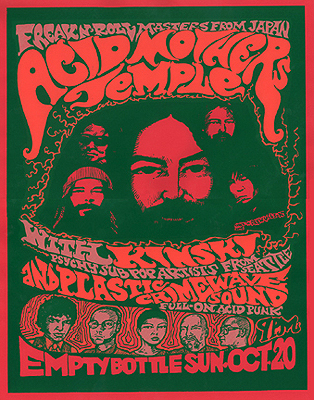
No matter: they'd rather be listening anywhere else than on one of my photo tours. I'll get over it.
So I called Jeffrey Stewart. (You may recognize the name from poetry in previous issues of this publication, which I strongly urge on you. In fact, if you go into the archive and read his previous Mayakovsky translation NOW then you'll feel really connected to what's going on when I insert some of Jeff's new Mayakovsky translations into the body of this essay later on. Trust me on this.)
Jeff had no interest following me around as I photographed road-kill or those twisted and anthropomorphic shopping carts hurled down overpasses to the foot of concrete supports. Alright then, could he suggest a location, and we could visit it independently and then he could contribute something, and I'd put it together. Jeff responded that he didn't work to deadlines.
Aright, then, could he suggest a location and be done with it. He could: the vacant lot behind the Tim Horton's at Rymal Road and Nebo Road. There was a sign, in particular, that he found particularly evocative.
Visiting someone else's location is unsettling. It's like getting the use of a friend's cottage. You stand around for a bit in the cottage itself, wondering how to turn on the lights, and then wander out to the boat house and ask yourself what the etiquette might be around putting on your friend's snorkel and flippers and going for a dip.
There is a suspicion of unknown hazards. Is there a rash people get if they swim for longer than ten minutes? Are there rays that sting? Is there a triangulated patch on the lake from which no windsurfer has ever returned?
But following Jeff's instructions I went out to Rymal and Nebo, and began, as I always do when I don't know what to do, by photographing signs.

This is baffling, as ingress and egress are fully asphalted, complete with helpful arrows.
More worrisome of course was the icon announcing the toxic grass.

Naturally I stood not exactly on the grass, but close to it, to take this photo, and later that day I went to bed with a headache, exhausted and nauseous. No doubt the pesticide did it. One takes such health risks in the interest of documentary. I thought of John Howard Griffin, author of Black Like Me. A white man from Texas, in 1959 he took oral doses of Oxsoralen in order to dye his skin dark enough to experience the life of an African American in the segregated South.
He spoke of the lethargy and nausea he experienced from the medication. I'm not making a value comparison between Griffin's civil rights work and what I'm doing, I'm just say that documentary work is about continuous risk, and nowhere in his book does Griffin lament that his friends won't take a hit of Oxsoralen and walk a mile in similar shoes so that Griffin has someone to chat with. Get over it Mark, I say to myself, feeling righteous and tough and lone.
What interested me was the idea of cultivating a green, flawless, lawn on an intersection that offers views like this.
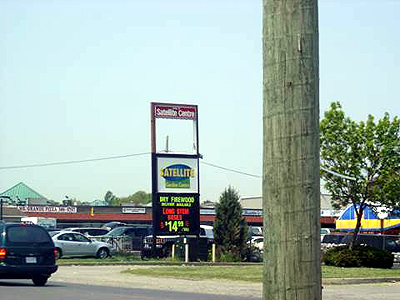
It was unfathomable to me. So I called the number on the sign and explained that I hadn't been feeling well. Hesitantly, the woman took my number down and said I needed to talk to the person at the health desk. Fair enough. It wasn't like I'd been bitten by an Australian Copperhead while on the property and was calling for them to ship me the anti-venom.
I was well enough to sit up now, and I could certainly write about other things while I was waiting for the health desk to call me back.
I was, however, interested in the pesticide sign purely for aesthetic reasons, contemplation of which exposed me to greater toxins that I really needed to be exposed to if I'd simply stayed in an air-conditioned vehicle like a sensible citizen idling slowly up to the drive-through window. Isn't the point of icons to speak to people who either don't read the language or are moving too quickly to digest words?
Who, seeing the walking man with a line through him, would understand that this was a sign about pesticides? From a non-verbal perspective it tells me not to walk around here for fear of being run down by motorists racing to the drive through (perhaps inducing me to leap to safety on the grass.)
I have long been fascinated by the iconic faceless man who is always forbidden from things or warned against things.

For years when I've been out walking with my children and am hard up for things to talk about I have contrived stories about this man, who sometimes tells us it's safe to walk, sometimes tells us where to dump our garbage, and where not to dump our garbage, sometimes tells us where to find a washroom when we are male, and puts on a skirt to tell us where to find a washroom when we are female - I'm sorry, he may be wearing a skirt, but the women's washroom icon just DOESN'T look female to me.
One of our favourite ongoing stories is in a restaurant where the icon on the waste disposal flap is interested in the cross-dresser on the women's washroom even though s/he is currently dating the icon on the men's washroom.
Another involves the Walking Man getting fed up with long hours and low pay, and how he goes off and sits in the tavern across the street and buys everyone a drink and plays bar pool by himself because not having a mouth he can't ask the No Smoking icon to join him, and when the Red Hand Sign comes down off the traffic light to look for him the Red Hand is SO MAD HE'S FLASHING.
(I realize I'm probably a long way from producing children's texts which get bound into tall, handsomely illustrated books I'm invited to come into a bookstore and sign on Saturday afternoons, but my own children tolerate these stories.)
One of the problems I've experienced as a story teller is the fact that the facelessness makes these characters stoic and psychologically impenetrable. As they all have the same personality I find it a challenge to build drama in these scenarios. The stories always feel like a bunch of guys sitting around at a bus station.
Jeff had mentioned the stunning collections of garbage, which existed in an ongoing dynamic of chaos and order, as garbage was dumped, dispersed, pushed back into piles, and ultimately taken away.
I thought of the stanza in Bob Dylan's "Highway 61" which goes:
Well Mack the Finger said to Louie the King,
"I got forty red white and blue shoe strings
And a thousand telephones that don't ring
Do you know where I can get rid of these things?"
And Louie the King said "Let me think for a minute son."
And he said "Yes, I think it can be easily done
Just take everything down to Highway 61."
Substitute Rymal and Nebo for Highway 61 and you've got an idea about the place. You could probably find all that stuff Bob mentions if you brought a shovel and turned over enough things.
Although - I'm not suggesting you take Louie the King's advice and come out and dump things here, as I'm sure you'd be subject to fines or even a prison sentence:
Prisoner 1: Hey! Big guy. Whatcha in for?"
Prisoner 2: Ahhh! The Finest caught me dumpin' at Nebo and Rymal.
Prisoner 1: Oh MAN. Not you TOO! First offence?
Prisoner 2: Third. Judge DICKHEAD thinks that should be punishable by a jail term.
Prisoner 1: Yeah, rilly. Like dumping would ever be NOTICED in Hamilton.
Prisoner 2 Hey, listen, they said you were the guy to talk to about getting a tattoo. I wanna get, like, the stick guy you see on the No Smoking signs, only he's toking a spliff and there's no line through him, but it says under him, "JUST SAY YES." HA! Get it?
Prisoner 1: Where d'ya want it?
Here are some of the piles of junk Jeff was talking about.

And when you zoom in:
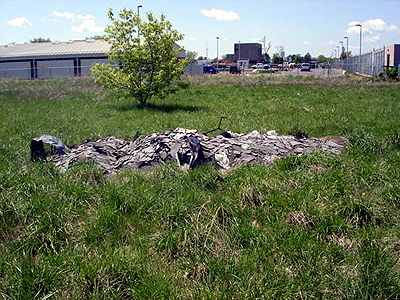
It was a really hot day and these shingles were off-gassing. As I said, I was already feeling ill so I didn't get any closer. But when I e-mailed these photos to him Jeff noted that the sheer range and power of the garbage wasn't what it had been, and I was in the awkward position of trying to imagine a) what it once was, and b) how Jeff would have responded then or now.
The situation was similar to what the great Japanese poet Matsua Basho describes in his travel book The Narrow Road to the Deep North (There HAS to be an Acid Mothers Temple album on the horizon called The Liquid Road to the Deep North Supernova. Send credit card number or blank cheque to order from me now and I'll ship it when it's released. Really, I will.)
My heart leaped with joy when I saw the celebrated pine tree of Takekuma, its twin trunks shaped exactly as described by the ancient poets. I was immediately reminded of the Priest Noin who had grieved to find upon his second visit this same tree cut and thrown into the River Natoir as bridge-piles by the newly-appointed governor of the province.
This tree had been planted, cut, and replanted several times in the past, but just when I came to see it myself, it was in its original shape after a lapse of perhaps a thousand years, the most beautiful shape one could possibly think of for a pine tree.
-The Narrow Road to the Deep North and other Travel Sketches, translated from the Japanese with an introduction by Nobuyuki Yuasa, Penguin, 1966.
I wondered what municipal office I should call to speak of cultivating deposits of garbage in carefully landscaped clumps with the ineffable perfection of a Zen rock garden, and if this was maybe a question I could ask of the person who was supposed to be calling me back about the health risks from pesticides. With a job like that they might have a listing of all the departments
As I was going by it anyway I stopped at Jeff's house to return one of his CDs.
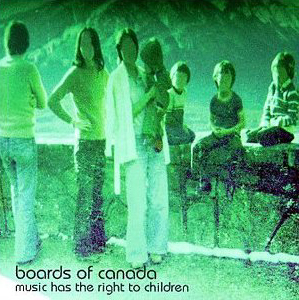
He wasn't home, so I left it in his mailbox. If you've never heard the Boards of Canada, it's the perfect music to play when you're up with a crying baby at 4:00am, channel surfing science documentaries with the sound down. (I was a Hall Director in a Residence at McMaster University when my children were born and got free cable, which I wouldn't have had otherwise.)
Seems like a low point when you're living it, but some days I want to get back there: the hallucinatory tiredness where you get weird creative ideas you don't have time to develop, and then have forgotten by the time you do; the mind numbing drudgery, where you don't even have time to process newspaper articles and forget briefly about the prospect of nuclear and environmental apocalypse, and, oh yeah, I already mentioned that: the free cable.
I miss it, but not often.
I wandered down Jeff's street. Cracks between drapes widened. I experienced the tingly feeling of being watched. Residents fear me. I have a camera. I found a particularly charming example of my friend the icon.
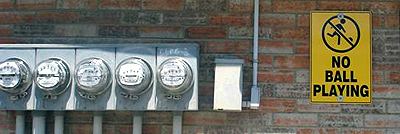
Shorts, larger head in relation to the body, more bounce to the stride, not at all like the world weary man poisoned by pesticides that he'll later grow up to. If only he had heeded his own good advice he might not have ended up like this:

Sure, he gets the good parking space, but that's small compensation. Children, heed the icon for whom it is too late. Don't play ball in traffic.
After stopping at Jeff's I went to the mall, to see if anything would suggest a pattern. As though the anonymous INteriority of the mall, by being the inverse of the vacant lot's anonymous EXteriority, would force a meaning on my fieldwork. But nothing spoke to me.

After I got home I sent Jeff a message with attachments of the signs I'd photographed and then I trawled the internet for samples of NO SMOKING signs. I found hundreds, but not the one I was looking for. It's one I saw only once on a cigarette pack littered outside the Toronto GO station. (I've never been a smoker, otherwise I'm sure I'd have saved to exacerbate my smoker's guilt and make myself quit).
It had three images of the icon people and all the parts of them that could be affected by cigarette smoke. Inside the black silhouette of the first one was an icon of the heart (i.e. heart disease); inside the second was an icon of the lungs (i.e. emphysema, lung cancer, asthma and all those other lung ailments I just don't want to think about) inside the third (and this is the one that stayed with me) was an icon of a fetus, correctly inverted, with a very large head in relation to its body (i.e. smoking while making a human being gets the human being off to a bad start).
It interested me that all three icons were simply:

Including the one with the fetus inside. As though gestating should not be gender specific. It was intended to represent a negative impact on pregnancy, but at the time my partner was pregnant with our first child, and I found the universality of the image almost more powerful and life-affirming than I could bear.
The icon of the human was so generic as to say that that all persons, male or female, are entangled in the future of the species. It also suggested that these icon people, who we see everyday, don't just appear fully formed on washrooms, but they get together, they link, they reproduce, they raise their kind.
How could images so simple be so desperately moving? The more so now that I can't find it, and have to run my memory in circles to recreate it.
Jeff returned my e-mail, saying that I had still missed the sign that had impressed him. He had been continuing to make trips to Rymal and Nebo, though his visits never corresponded to my own. (It would have been strange had we met there and talked and walked together and this essay would have been way different.) He DID have something to share for the essay. He said being there reminded him of the last written words the Russian poet, Vladimir Mayakovsky.
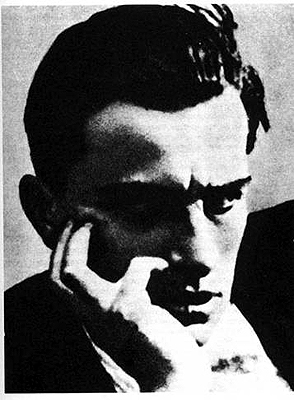
But why am I telling you this when I can just quote from the email?
Oddly, your pictures made me want to go back to Mayakovsky. So here are two of my imitations of fragments found on his person after his suicide. The most famous one I posted on RTH. Perhaps the uncared-for barrenness of the Rymal landscape made me think of him and how alone he was at the end.
And here they are (See. I told you you should go back and read Jeff's previous submissions.)
TWO BY MAYAKOVSKY
She loves me, she loves me not? I wring my hands and throw away the broken fingers like the petals which we used to play games - pulled and tossed to tell of the fortunes of May.
The grey hairs - my barber has been made aware but if they should suddenly shoot out like silver- I hope, I believe, that you will never discover the common shame that has sold me down the river.
If these fragments have been better translated, I'd like to see it. The words were striking enough to send me back to Rymal and Nebo yet again. I photographed still more signs, and more of the landscape, not knowing at all, by now, what I was doing. The most noteworthy thing I saw this trip was these bits of toilet paper caught in the trees.
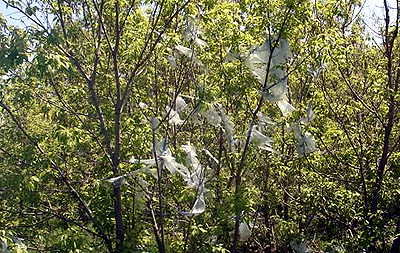
Back when I was a Hall Director at McMaster University, one of the things I looked forward to every fall was the ritual the students had of draping the trees of the North Quad with toilet paper, an effect strangely similar to the photo above. It would seem that this had been going on as long as anyone could remember. In the early years it was treated with scorn by the housing office.
Then it was tolerated as something the residence authority could do little about, and which, after all, was less serious than students climbing the exterior of residences while drunk, or lining washing-machines with garbage bags and then using the machines to mix overripe fruit and cheap alcohol into a punch (don't try this; it doesn't work as well as you imagine it will half way into a keg party).
Then it became so much a part of rhythm of the year that it gave a sense of continuity and tradition. The residence staff themselves would join in removing the toilet paper after a few days of it just hanging there. They even looked forward to it.
It was like the Kafka parable:
Leopards break into the temple and drink the sacrificial chalices dry. This happens again and again, repeatedly. Finally it can be counted on beforehand and becomes part of the ceremony.
I found more ceremony and ritual just up ahead in this array of discarded chairs around a discarded table. The table is narrow and alterlike, the chairs spare and pewlike. The whole arrangement feels sacred; remote. What retreat could be farther from interruption than this? (Don't ask me who you'd call to book this space.)

So I sent my whole new batch of photos over to Jeff, who informed me that I still hadn't found the sign he was referring to. To help me along he sent this unsurpassably desolate view of Rymal and Nebo. Not really all that helpful though, since it contains a number of signs, none of which are readable.
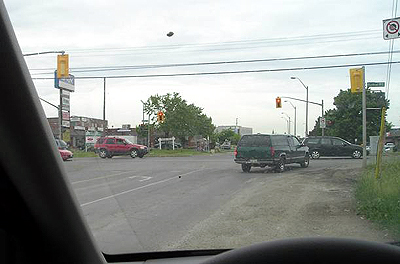
He also told me he had been listening to Schubert's Piano Sonata in G Major D. 894, which was, in his words "almost the music to this landscape."
I spanked the Radu Lupu performance (my recommendation if you've never heard it and are looking for an entry point) of the D.894 onto my CD drive. I was struck by the famous phrase from the opening bars. It may be trite to say this, but like so much late Schubert it's childishly simple and transcendent at the same time. I went back to my photos and noted the warehouse at the end of the long view of the vacant lot.
I've always had trouble with critics who compare music to landscape, and I'm sure not a pro at musical analysis. But I took a closer listen and a closer look, and realized that if you measured the angle of the gently rising and falling notes in the opening phrase of D.894
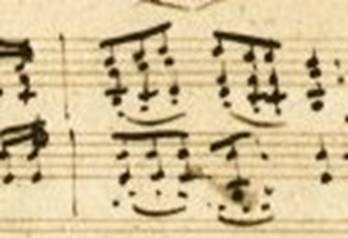
with the angle of the gently rising and falling roof of the warehouse behind Rymal and Nebo

you couldn't help but agree that Schubert had nailed it; that he'd laid down a wicked soundtrack to the Rymal and Nebo experience.
None of this helped me identify the sign though. Rather than being a good sport and continuing to play the game of tracking down the sign following his clues, I picked up the phone and demanded Jeff tell me what the hell he wanted me to look at.
He told me. I went back and photographed it.
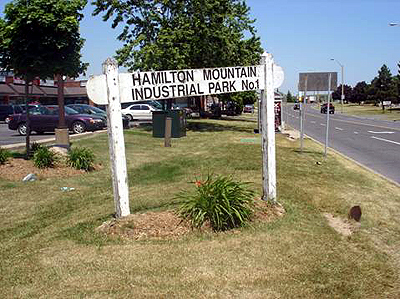
It's good. Easy enough to miss. Remarkable for the fact that it seems to predate all the development around it. As one would plant a flag to mark conquered land on Mount Everest, or the moon or somewhere like that. Useful reference for motorists too I suppose. I'm interested in the fact that someone chose to decorate it with a plant (this flora is not, I'll go out on a limb here, indigenous). The leaves haven't been chewed away, so obviously the pesticiding helps.
It feels like a mixed media sculpture, or an urban oasis. It is flowering, but one can't, I don't think, imagine Mayakovsky, even in happier times, approaching it as he did the "petals which we used to play games-pulled and tossed to tell of the fortunes of May."
OK, so, since I was here, I walked over to look at the gathering of chairs again, because I am a man who embraces habits, patterns and routines. Like Kafka's people, I too like it that the assault of the leopards can be predicted and relied on.
But what horrors met me when I returned to the table and chairs!
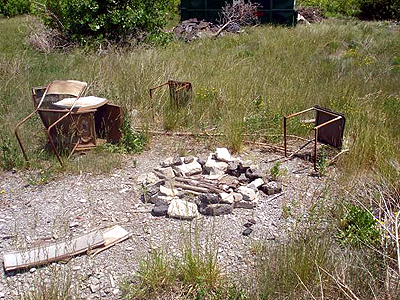
The detective in me compared the two photos. The rocks and contents of the fire pit hadn't changed since last time. It was only chairs that had been toppled. And so consistently, without moving any real distance from each one's initial footprint, that I couldn't imagine the wind having done it.
People had come together for a meeting and the meeting had gone badly. Maybe even ending in violence. My reference was immediate. The "Black and White Jacksons" passage from Cormac McCarthy's Blood Meridian.
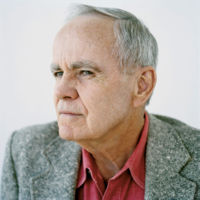
Blood Meridian is a Literary Western set against the backdrop of the Mexican/American war the large-scale massacre of indigenous peoples in the Mexican/American borderlands in 1849-50. In a company of dubious men, a "conflict" emerges between two of them, both by chance named Jackson, and "both forenamed John". One happens to be black, the other white. The shared name is an affront to White Jackson and he spends his days taunting Black Johnson.
This is untamed, uncharted country. "Beyond men's judgments all covenants were brittle." There's no one in the company trained in Alternate Dispute Resolution (ADR) like we have in today's corporations, which would facilitate Black Jackson and White Jackson expressing grievances and then building an action plan to resolve them get the hell on with the work they're being paid to do.
No. The company they ride with KNOW it will end violently, and it does. One evening Black Jackson approaches the campfire White Jackson is sitting at-here's where the setting of my photograph, with the campfire and the disorder and all, reminds me of this passage - and White Jackson is having none of that.
The white man swung his head, one eye half closed, his lip loose. His gunbelt lay coiled on the ground. He reached and drew the revolver and cocked it. Four men rose and moved away.
You aim to shoot me? said the black.
You dont get your black ass away from this fire I'll kill you graveyard dead.[…]
Is that your final say?
Final as the judgment of God.[…]
The white man uncocked the revolver and placed it on the ground before him. Two of the others came back to the fire and stood uneasily. Jackson sat with his legs crossed. One hand lay in his lap and the other was outstretched on his knee holding a slender black cigarillo. The nearest man to him was Tobin and when the black stepped out of the darkness bearing the bowieknife in both hands like some instrument of ceremony Tobin started to rise. The white man looked up drunkenly and the black stepped forward and with a single stroke swapt off his head.
Two thick ropes of dark blood and two slender rose like snakes from the stump of his neck and arched hissing into the fire. The head rolled to the left and came to rest at the expriest's feet where it lay with eyes aghast. Tobin jerked his foot away and rose and stepped back. The fire steamed and blackened and a gray cloud of smoke rose and the columnar arches of blood slowly subsided until just the neck bubbled gently like a stew and then that too was stilled. He sat as before save headless, drenched in blood, the cigarillo still between his fingers, leaning toward the dark and smoking grotto in the flames where his life had gone.
--Cormac McCarthy, from Blood Meridian or The Evening Redness in the West
I was hoping I could find these passages on the internet, rather than digging through boxes for my own edition (those of you who follow these essays, no, I still haven't fully unpacked since my move.) All I came up with on the internet was a Washington DC indie band named Black and White Jacksons whose web-page appears to have their name spelled out in scrabble letters and that's about all the info you get.
They also have a 50 second posting on YouTube called "Dickin' 'Round", which title is apt.
We all like keeping in touch with the cultural scene of the city that wields more global influence than any other. Like the incident from which they take their name the image of masked men in a room beating wild patterns on drums and guitars haunts me, as though it were a snippet from the eternity playing within White Jackson's severed head.
Here, at Nebo and Rymal, I feared finding any remnants of such a conflict. If there had been a head and a body, it had been cleared up. I'll attest to feeling a strange queasiness, a malign energy around this site. I could still be feeling the effects of pesticide.
[Speaking of which, a representative of Heritage Green, the company attached to the number I had called, had returned my call the day before. This "Health Counsellor" [?]-somewhat randomly I thought-assured me that what I had inhaled was nothing more or less than "the sort of thing you'd buy at Canadian Tire to kill dandelions."
I was baffled by this non-sequitor, in particular by his use of the second person. The presumption of it. For the record, I have never bought weed-killer in my life, at Canadian Tire or anywhere else. While his statement did not address my question about health risks his tone suggested that the information he was giving me should dispel all concerns. [?!]
Okaaay... I could tell where this conversation WOULDN'T be going. By this point it wasn't a battle I was prepared to take on. I was probably overreacting anyway. Sure I'd gotten a bit ill from toxic gasses, but I was certainly doing better than White Jackson.
Am I going to, like Mayakovsky, write some tender poetry and then cancel myself just because the world is a little bit harsh and toxic? No. I may not be John Howard Griffin but I'm made of stronger stuff than that.
So, thinking I might at least learn something useful I changed tactics and asked if it was city property or if the company it surrounded paid for it. His answer was that the business on the corner of Rymal and Nebo hired their company. And without me realizing that I'd said good-bye, my Health Counsellor was gone. So there's our answer.
This band of grass on a stretch of road without sidewalks, grass that is mostly approached by people in vehicles who don't even want to shut down their internal combustion engine to buy a cup of coffee, is kept pristine and green at a mild cost to the human respiratory system.]
I moved on from the plundered meeting place to a fine collection of discarded objects.
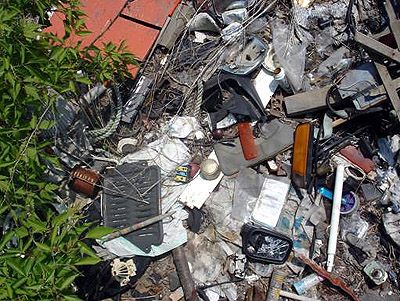
Swept up on Highway 61 and dumped out here.
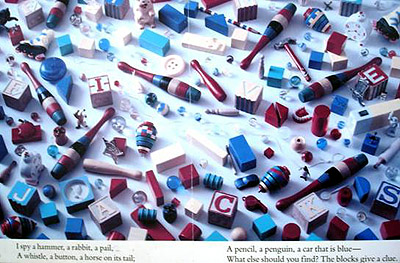
There is, in the Main Street West Dairy Queen, a plaqued picture-game thus:
Something that can occupy the tots as they ingurgitate their frozen milk products rather than running madly around the place and wreaking havoc when the sugar hits their nervous system.
I figured I could do something similar with my picture. Something like:
Find a smashed mirror,
A reflector that's orange-
A rusted tin can,
a paint lid, a door hinge.
You get the idea.
I was getting odd looks from the staff of the Dairy Queen, so I bought an ice cream. They had just mopped the floors and posted a warning showing the icon in a particularly playful mood.
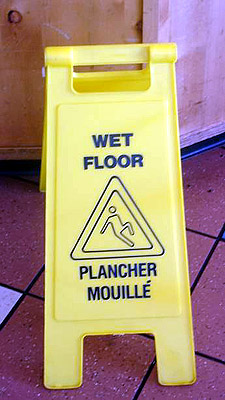
Really, a person understanding neither French nor English would feel they were being commanded to leap in the air and click heels, which would be particularly hazardous on a wet floor.
Heading North up New Street from Dairy Queen eating my iced milk product (which was quite nice on a hot day. Keep turning as you lick, it tends to drip) I stopped dead in my tracks. For there he was.
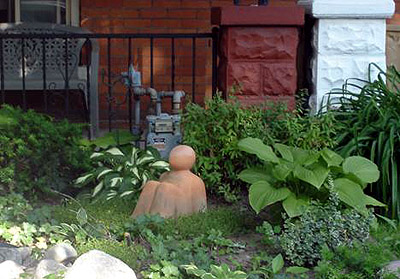
Three dimensional. Serene. Not directing me. Not warning me. Just being there. Real. This was his essence. The images I'd been collecting where mere representations. Like the shadows on the wall in Plato's cave. Also something in his posture suggested Belcaqua.
Among them one,
Who seem'd to be much wearied, sat him down,
And with his arms did fold his knees about,
- Dante: Purgatory, Canto IV, Translated by Charles W. Eliot
I perceived someone idle, melancholy, but also someone who'd come through his personal hell and found something we might call peace (in a way Vladimir Mayakovsky, for example, ultimately couldn't.) I imagined hearing him sigh at the tedium of his sentence. I imagined the clay arms at his sides rising slowly to embrace his knees, willing himself to endure. The historical gloss tells us that Belacqua was a talented musician who just didn't produce nearly as much as he should have. If you're like me, you'll be thinking of the 40 years it took Brian Wilson to release "Smile,"
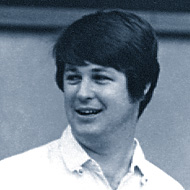
but I know there were some psychiatric issues there, and, as often happens when I approach the end of an essay, I'm getting tired and mean-spirited, and I'm learning to watch for that in my writing. I'd actually like to hear one of Belacqua's CDs just to see if, as with Mr. Wilson, we could make a case for quality making up for lack of quantity.
But for the sake of conforming to God's judgement I'll pretend he's just one of the musicians in the Black and White Jacksons "Dickin' 'Round" video. Anyway, the point is that God punished Belacqua by stranding him at base camp of Mount Purgatory and wasting an amount of Belacqua's time equal to the time Belacqua wasted on Earth.
(Mr. Holden, my Grade 10 Chemistry teacher used to do something like that to Lynden Lyndall and me, by giving us detentions equivalent to the class time we'd wasted with our shenanigans.)
I suspect God's judicial style has changed since 14th Century Florence. The God of our industrious, Type-A society would probably sentence Belacqua to a lifetime of community service: directing people into appropriate washrooms, helping people cross streets, cautioning people about wet floors, helping the handicapped park, and forbidding those activities who's consequences are almost too horrifying to imagine.
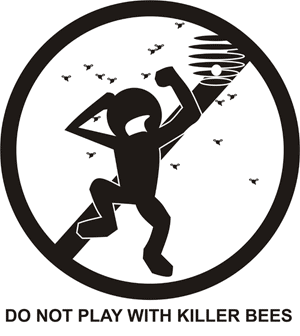
By trey (registered) | Posted September 04, 2007 at 11:57:19
Brilliant as usual Mark
You must be logged in to comment.
There are no upcoming events right now.
Why not post one?